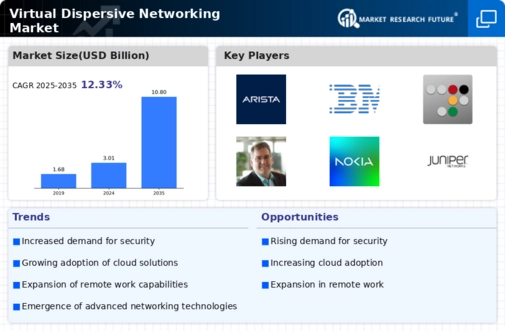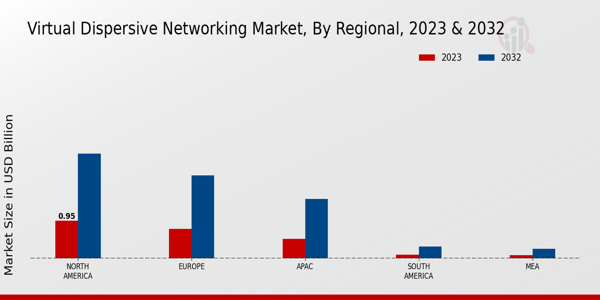Increasing Cybersecurity Threats
The Global Virtual Dispersive Networking Market Industry is experiencing heightened demand due to the increasing prevalence of cybersecurity threats. Organizations are increasingly recognizing the necessity of robust security measures to protect sensitive data and maintain operational integrity. Virtual dispersive networking offers a unique approach by obfuscating data packets, making it difficult for malicious actors to intercept or manipulate information. As cyberattacks become more sophisticated, the market is projected to grow from 3.01 USD Billion in 2024 to an estimated 10.8 USD Billion by 2035, reflecting a compound annual growth rate of 12.35% from 2025 to 2035.
Growing Adoption of Cloud Services
The Global Virtual Dispersive Networking Market Industry is witnessing substantial growth driven by the increasing adoption of cloud services across various sectors. As businesses migrate to cloud-based solutions, the need for secure and efficient data transmission becomes paramount. Virtual dispersive networking enhances the security of cloud communications by dispersing data across multiple paths, thereby reducing the risk of interception. This trend is particularly evident in industries such as finance and healthcare, where data integrity is critical. The market's expansion is indicative of the broader shift towards cloud infrastructure, which is expected to significantly influence the industry's trajectory in the coming years.
Regulatory Compliance Requirements
The Global Virtual Dispersive Networking Market Industry is significantly influenced by stringent regulatory compliance requirements across various sectors. Organizations are compelled to adhere to data protection regulations, such as GDPR and HIPAA, which necessitate the implementation of advanced security measures. Virtual dispersive networking provides a viable solution by ensuring that data is transmitted securely and in compliance with regulatory standards. As organizations strive to avoid hefty fines and reputational damage associated with non-compliance, the demand for virtual dispersive networking solutions is likely to rise. This trend underscores the importance of integrating compliance into security strategies, further propelling market growth.
Rising Demand for Remote Work Solutions
The Global Virtual Dispersive Networking Market Industry is experiencing a surge in demand for remote work solutions, as organizations increasingly adopt flexible work arrangements. Virtual dispersive networking provides a secure means of communication for remote employees, ensuring that sensitive data remains protected while being transmitted over potentially insecure networks. This trend is particularly relevant in sectors where remote work is becoming the norm, such as technology and professional services. As companies continue to invest in remote work infrastructure, the need for secure networking solutions is likely to grow, further contributing to the expansion of the virtual dispersive networking market.
Technological Advancements in Networking
The Global Virtual Dispersive Networking Market Industry is benefiting from rapid technological advancements in networking technologies. Innovations such as software-defined networking and artificial intelligence are enhancing the capabilities of virtual dispersive networking solutions. These advancements enable more efficient data routing, improved network performance, and enhanced security features. As organizations seek to leverage these technologies to optimize their networking infrastructure, the demand for virtual dispersive networking is expected to increase. The integration of cutting-edge technologies not only improves operational efficiency but also positions organizations to better respond to emerging cybersecurity threats, thereby driving market growth.






















Leave a Comment